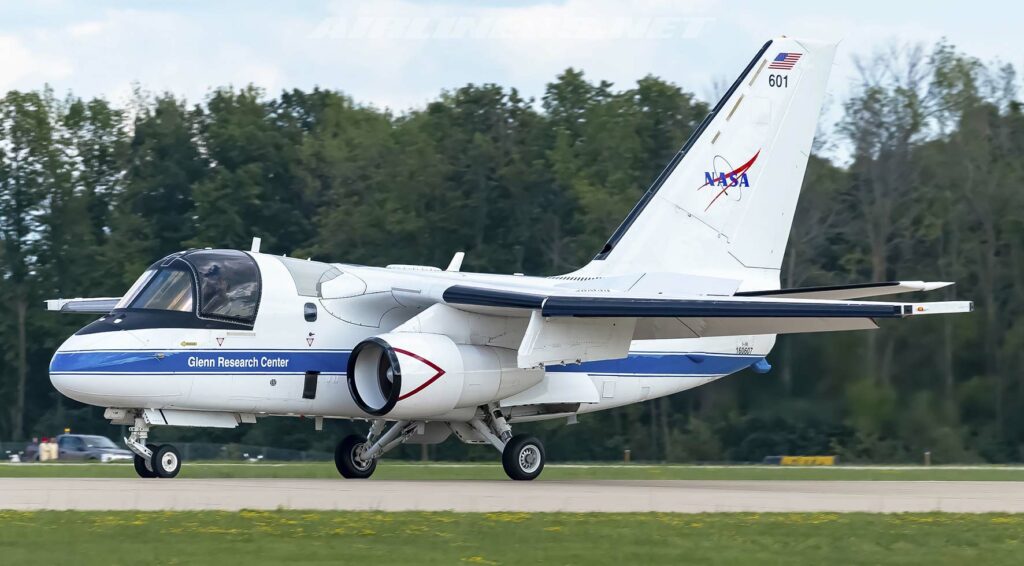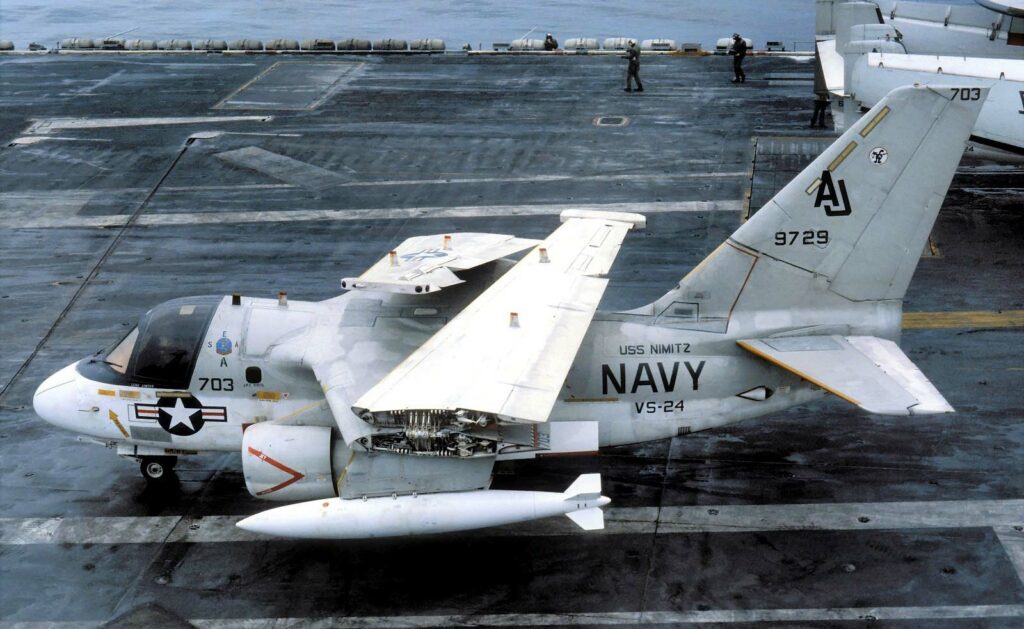Anti-submarine warfare (ASW) carrier-based jet aircraft, Lockheed S-3 Viking, turbofan-powered, 4-crew.
In brief
The Lockheed S-3 Viking is a twin-engine, turbofan-powered aircraft designed primarily for anti-submarine warfare (ASW) operations. With a length of 53 feet and a wingspan of 68 feet, the Viking is capable of operating from aircraft carriers. Its design includes a high-wing layout for stability and visibility, retractable magnetic anomaly detector (MAD) boom, and internal weapons bay. The aircraft is equipped with state-of-the-art sensors for submarine detection, including radar, sonobuoys, and electronic support measures. Its turbofan engines provide a balance between speed and fuel efficiency, enabling long-duration missions over vast ocean areas. The S-3 Viking also features carrier-based capabilities, such as catapult launches and arrested recoveries, making it a versatile asset for naval operations.

The Lockheed Vought S-3 Viking special aircraft
The Lockheed Vought S-3 Viking emerged during the Cold War, a period characterized by technological advancements in military hardware, as nations prepared for potential confrontations on a global scale. The increasing threat posed by Soviet submarines to the United States’ Navy carrier groups necessitated the development of a dedicated anti-submarine warfare (ASW) aircraft. The S-3 Viking was Lockheed’s answer to this challenge, developed to replace the aging Grumman S-2 Tracker.
Launched by the United States Navy in the late 1960s, the Viking’s development was a response to the need for an advanced, carrier-based aircraft capable of detecting and engaging enemy submarines from great distances. Its first flight took place on January 21, 1972, a significant milestone that marked the beginning of a new era in naval aviation.
Designed with the latest in radar, sonar, and computer technology, the Viking was adept at long-range maritime patrol, electronic warfare, and surface surveillance. This multi-role capability allowed it to protect carrier groups and maintain a watchful eye over vast oceanic expanses. The aircraft’s development was not just a testament to technological innovation but also a strategic move to maintain naval superiority.
Design of the Lockheed Vought S-3 Viking:
The Lockheed Vought S-3 Viking’s design is a blend of functionality and technological advancement. Measuring approximately 16.26 meters (53 feet) in length with a wingspan of 20.72 meters (68 feet), the Viking’s high-wing configuration enhances stability and visibility during low-altitude missions. Its twin turbofan engines, mounted on the fuselage, provide a thrust-to-weight ratio that balances speed and endurance, allowing the aircraft to loiter over operational areas for extended periods.
Equipped with an internal bay for torpedoes and other anti-submarine weapons, the Viking’s design minimizes drag and preserves stealth, crucial for ASW operations. The aircraft’s retractable MAD boom is another hallmark, enabling it to detect submerged submarines by identifying anomalies in the earth’s magnetic field. This feature, combined with advanced sonobuoys and integrated sensor systems, makes the S-3 a formidable ASW platform.
One of the design’s drawbacks was its limited speed and agility compared to fighter jets, a trade-off for its endurance and stability. However, its capability to refuel other aircraft extended its utility beyond ASW roles, demonstrating its versatility.
Performance of the Lockheed Vought S-3 Viking
Powered by two General Electric TF34-GE-400B turbofan engines, the Viking exhibits notable performance characteristics. It achieves a top speed of 450 knots (833 km/h) and can operate at altitudes up to 40,000 feet (12,192 meters). With a range of 2,300 nautical miles (4,260 kilometers) without refueling, it can cover vast areas during patrol missions.
Comparing the S-3 Viking to contemporaneous ASW aircraft, its blend of speed, range, and onboard technology positioned it advantageously. While not the fastest aircraft, its operational flexibility, especially in carrier-based operations, set it apart. Its ability to conduct in-flight refueling further extended its range and mission capabilities, underscoring its strategic value.
Variants of the Lockheed Vought S-3 Viking
The S-3 Viking evolved through several variants, each designed to fulfill specific roles or improve upon the base model’s capabilities. The S-3A was the initial production model, equipped with the baseline ASW and surveillance technology. The S-3B variant introduced an upgrade in radar and sonobuoy processing capabilities, enhancing its effectiveness against newer submarine threats.
Another notable variant was the ES-3A Shadow, modified for electronic warfare and signals intelligence missions. Its sophisticated sensors and communications equipment enabled it to gather intelligence, proving critical in network-centric warfare environments. Each variant of the Viking underscored the aircraft’s adaptability to evolving military requirements.

Military Use and Combat of the Lockheed Vought S-3 Viking
In its decades of service, the S-3 Viking distinguished itself as a versatile tool in the U.S. Navy’s arsenal. Its primary armament included torpedoes, mines, and depth charges, specifically tailored for anti-submarine warfare. Additionally, it was capable of deploying an array of sonobuoys, further enhancing its ASW capabilities.
The Viking saw extensive use in various conflicts, notably during the Gulf War, where it conducted surveillance, electronic warfare, and tanker missions. Its ability to gather intelligence and provide real-time data to the fleet showcased its strategic value beyond traditional ASW roles.
Throughout its service life, the S-3 competed with aircraft like the P-3 Orion in ASW roles, each having distinct advantages. While the P-3 offered longer range and higher payload capacity, the S-3’s carrier-based flexibility and multi-role capabilities made it a unique asset.
The S-3 Viking was phased out of active duty in the U.S. Navy by the mid-2000s, replaced by platforms like the P-8 Poseidon and MH-60 Seahawk in ASW and surveillance roles. However, its legacy continues in various forms, including use as research platforms and in reserve fleets, underscoring its enduring contribution to naval aviation.
–
Despite its retirement, the S-3 Viking remains a subject of interest for military aviation enthusiasts and historians. Its development and operational history reflect the technological advancements and strategic shifts of the late 20th century. The Viking’s legacy is not just in the missions it flew or the conflicts it participated in, but also in its contribution to the evolution of naval aviation tactics and technology. Its adaptability and multi-role capabilities set a precedent for future generations of military aircraft, underscoring the importance of versatility in military assets.
The S-3 Viking’s journey from a frontline ASW platform to a versatile tool in environmental research and reserve operations illustrates the adaptability of military technology to new roles. While the skies over carrier battle groups no longer hear the distinctive hum of the Viking’s turbofan engines, the lessons learned from its service continue to influence the development and deployment of future naval aviation assets.
Back to the Special Aircraft section